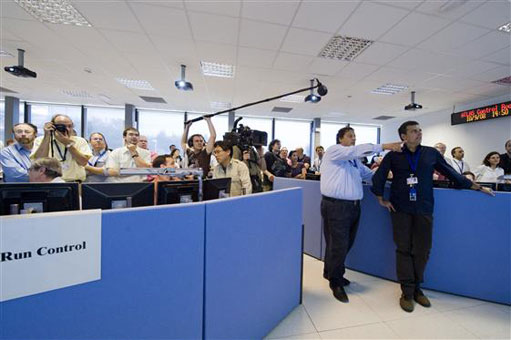
ATLAS e-News
23 February 2011
First Physics Day
25 January 2010

Unlike 10 September 2008, no journalists will be admitted into the Control Room come First Physics Day (photographer: Claudia Marcelloni)
We had beam; we had collisions; we had collisions with stable beams and the full ATLAS detector switched on; and we had the highest energy collisions ever recorded at an accelerator. Not bad for three weeks work in the run-up to the Christmas break. But this time around – softly, softly – there was a distinct lack of media fanfare onsite.
That’s because, while in 2008 we had the (in hindsight, unfortunately named) Big Bang Day, this time the spotlight will instead be on First Physics Day, scheduled for late February.
Collisions at 7 TeV, – between two beams of 3.5 TeV each – will take us into new and unchartered physics territory. Once bitten, twice shy, so this time the plan is to wait out several weeks of quietly getting to know the detector and the LHC machine before inviting the global media onsite to witness first-hand the pressure and excitement of achieving collisions at groundbreaking energies.
Until this point, communication with the media about the 2009 start-up has been done via press releases and a single press conference on Monday November 23rd, following the first low-energy collisions. But First Physics Day – which is being planned in detail by the LHC and experiments in conjunction with central CERN administration – presents a trickier organisational scenario than Big Bang Day.
For starters, the science itself is tougher to explain; high-energy collisions and what they might reveal, rather than simple circulating beams. But, more than that, it is difficult to know in advance precisely when high-energy collisions will occur. Already approximately 180 media representatives have signed up to visit, but when the time comes, they will only have 48 hours advance notice to make it to CERN. Indeed, ‘First Physics Day’ could well span up to five days in the event, since the LHC experts are unable to give more accurate predictions.
The media will be based in the pump hall (Building 216) and they will visit the control rooms of the four experiments on a rota basis. From here, ATLAS will be poised and ready to respond to any requests for help from CERN throughout the day.
No press will be allowed into the ATLAS Control Room itself, but a big screen will be placed on the first floor of the ATLAS Visitors’ Centre, streaming the output of the new audiovisual mixing system, ‘ANYCAST’.
ANYCAST operators from the ATLAS Outreach team will live-mix footage from two remote controlled HD cameras in the Control Room, a feed from a third free-camera within the Control Room, event display images and animations produced in situ by Markus Elsing and his team of data quality experts, images from a team of photographers inside the Control Room, and animated clips with background information on ATLAS. Steve Goldfarb will provide a narration over the top of the ANYCAST output, and the whole thing will be webcast for collaborators the world over, for CERN’s coverage of the day, and for the ATLAS public website.
Media visits to ATLAS will be run in hourly blocks, with each TV crew or press representative accompanied by a media-trained ATLAS physicist. The ATLAS Visitors’ Centre will host up to three TV crews and one photographer per hour, who may record images through the glass window, with an optional audio feed from inside the Control Room. The first floor will be reserved for radio and print journalists – up to twelve per session – to conduct one-on-one interviews. And on the second floor, just one TV crew will be allowed into each of the data quality and computing satellite control rooms at any time, leaving the shifters to do what they do best with minimal disturbance.
Special arrangements are being made for collaborators too. The ANYCAST feeds will be broadcast live to screens in the building 40 atrium, where people will be encouraged to gather and enjoy the feeling of community, expectation, and hopefully celebration, with colleagues and friends. As before, souvenir photos of the first magic events will be available from the ATLAS Secretariat shortly after they occur.
For those offsite, The ATLAS Now page will be constantly updated with news, event display images, Control Room photos, the ANYCAST webcast, and twitter updates.
 Ceri PerkinsATLAS e-News
|